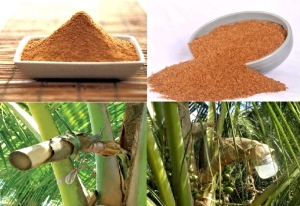 Coconut sap sugar is a natural sweetener derived from tapping the unopened inflorescence of the coconut palm (PNS/BAFPS 76:2010). Coconut sap sugar production is a simple farm-level technology involving a Natural process of heat evaporation to convert liquid sap to solid form of sugar granules.
Coconut sap sugar is a natural sweetener derived from tapping the unopened inflorescence of the coconut palm (PNS/BAFPS 76:2010). Coconut sap sugar production is a simple farm-level technology involving a Natural process of heat evaporation to convert liquid sap to solid form of sugar granules.
Uses and Health Benefits:
1. Based on the Food and Nutrition Research Institute (FNRI) study in 2007, the glycemic index (GI) of coconut sap sugar is 35, hence classified as Low GI food which can be used as natural sweetener for diabetics.
- GI is a ranking system for carbohydrates based on the immediate effect on blood glucose levels
- Low GI food will cause a small rise in blood glucose level. High GI food will trigger a dramatic spike. The higher the GI value, the greater the blood sugar response.
2. Coconut sap sugar can be a better substitute for synthetic sugars. It can be used as a sweetener for coffee, tea, chocolate drinks as well as in bread and pastry making, and as a cooking ingredient.
How to make Coconut Sap Sugar:
Processing of Coconut Sap Sugar
Step 1: Selection of tree and collection of coconut sap
- Select bearing trees with healthy unopened inflorescence for tapping.
- Bend the mature unopened inflorescence downwards for 1 week to allow the flow of the sap after tapping.
- Tie the inflorescence with plastic twine and slowly pull them downwards.
- Tap the inflorescence by slicing at least 6mm using a sharp knife.
- Collect the liquid sap oozing out with the use of a plastic vessel. Coconut sap should be cooked 5 hours after tapping.
- Sap gathered must be evaluated for the following: color (beige to light brown), pH (=6), oBrix (13-14.5) and clearness (translucent-clear).
Step 2: Heat evaporation
- Boil the collected sap up to 115oC in a stainless wok.
- When the liquid is already boiling, remove the scum to avoid the formation of dark residues.
- The boiling of the sap will take about 3-4 hours to remove water depending on the amount of sap and cooking techniques.
Step 3: Conversion of Sap Syrup to Coconut Sugar
- Continuously boil and stir the sap to avoid burning.
- Once the sap becomes syrupy/viscous and heavy to stir, remove the wok from the fire and continue stirring to ensure granulation.
Step 4: Sieving and Drying the Coconut Sap Sugar
- Let the sugar cool down and continue pressing to break the lump.
- Sieve the sugar to have a uniform particle size to produce quality product.
- Dry the sugar in a stainless tray over a boiling water (steam drying) for 1 hour to lessen the moisture. Then let it cool.
Step 5: Weighing and Packaging
- Collect the cooled sugar in a big container and store overnight.
- Weigh and pack the sugar using the commercially available transparent polyethylene plastic bags.
For more details, contact:
FOOD PRODUCT DEVELOPMENT DIVISION
Albay Research Center
Research Development Branch
Philippine Coconut Authority
Banao, Guinobatan, Albay
Mobile: (0917)558-1447
Email: [email protected] or [email protected]
or
FOOD PRODUCT DEVELOPMENT DIVISION
Research and Development Branch
Philippine Coconut Authority
FPDD Plant, PCA Compound., Elliptical Road
Diliman, Quezon City, Philippines
Tel. No.: (02) 8928-4501 to 09
Fax No.: (02) 8926-7631
Email: [email protected]
Website: www.pca.gov.ph
Facebook Page (This link will open on a new window)
Source: www.pca.gov.ph